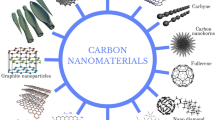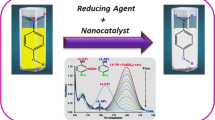Abstract
Highly fluorescent carbon quantum dots co-doped with selenium and nitrogen (SeN-CQDs) were fabricated via a one-pot hydrothermal route using selenomethionine as the sole precursor. The SeN-CQDs aggregates have sizes between 30 and 45 nm and display blue fluorescence with a quantum yield of 8% at excitation/emission wavelengths of 350/445 nm. The fluorescence is pH dependent and decreases under acidic conditions. The doping of the CQDs with selenium and nitrogen was proven by X-ray photoelectron spectroscopy (XPS). Fluorescence is selectively quenched by perfluorooctanoic acid (PFOA), and this is accompanied by a decreased fluorescence lifetime. Quenching is not due to aggregation in view of the unaltered sizes of nanoparticles as revealed by TEM and DLS analyses. UV-vis absorption titration suggested the formation of an excited state complex between SeN-CQDs and PFOA, and quenching originates from the internal electron transfer in the excited state complex. The method was used to detect PFOA quantitatively in the linear range of 10–70 μM with a 1.8 μM detection limit. The nanoprobe has a high selectivity for PFOA over potentially interfering molecules. The practicability of the method was ascertained by accurate detection of PFOA in real samples by the standard addition method. The method may be further improved by tuning the interaction between PFOA and SeN-CQDs through optimizing the doping and the surface composition of the SeN-CQDs.

Schematic presentation of a fluorometric method for perfluorooctanoic acid detection by using a selenium and nitrogen co-doped carbon quantum dots as the fluorescent probe.








Similar content being viewed by others
References
Renner R (2009) EPA finds record PFOS, PFOA levels in Alabama grazing fields. Environ Sci Technol 43:1245–1246. https://doi.org/10.1021/es803520c
Wojcik L, Korczak K, Szostek B, Trojanowicz M (2006) Separation and determination of perfluorinated carboxylic acids using capillary zone electrophoresis with indirect photometric detection. J Chromatogr A 1128:290–297. https://doi.org/10.1016/j.chroma.2006.06.049
Takayose M, Akamatsu K, Nawafune H, Murashima T, Matsui J (2012) Colorimetric detection of perfluorooctanoic acid (PFOA) utilizing polystyrene-modified gold nanoparticles. Anal Lett 45:2856–2864. https://doi.org/10.1080/00032719.2012.696225
Barber JL, Berger U, Chaemfa C, Huber S, Jahnke A, Temme C, Jones KC (2007) Analysis of per-and polyfluorinated alkyl substances in air samples from Northwest Europe. J Environ Monit 9:530–541. https://doi.org/10.1039/b701417a
Saito K, Uemura E, Ishizaki A, Kataoka H (2010) Determination of perfluorooctanoic acid and perfluorooctane sulfonate by automated in-tube solid-phase microextraction coupled with liquid chromatography–mass spectrometry. Anal Chim Acta 658:141–146. https://doi.org/10.1016/j.aca.2009.11.004
Trojanowicz M, Koc M (2013) Recent developments in methods for analysis of perfluorinated persistent pollutants. Microchim Acta 180:957–971. https://doi.org/10.1007/s00604-013-1046-z
Liu Q, Huang A, Wang N, Zheng G, Zhu L (2015) Rapid Fluorometric determination of perfluorooctanoic acid by its quenching effect on the fluorescence of quantum dots. J Lumin 161:374–381. https://doi.org/10.1016/j.jlumin.2015.01.045
Zhou J, Zhou H, Tang J, Deng S, Yan F, Li W, Qu M (2016) Carbon dots doped with heteroatoms for fluorescent bioimaging: a review. Microchim Acta 184:343–368. https://doi.org/10.1007/s00604-016-2043-9
Yang S, Li Y, Wang S, Wang M, Chu M, Xia B (2018) Advances in the use of carbonaceous materials for the electrochemical determination of persistent organic pollutants. A review. Microchim Acta 185:112. https://doi.org/10.1007/s00604-017-2638-9
Liu F, Jang MH, Ha HD, Kim JH, Cho YH, Seo TS (2013) Facile synthetic method for pristine graphene quantum dots and graphene oxide quantum dots: origin of blue and green luminescence. Adv Mater 25:3657–3662. https://doi.org/10.1002/adma.201300233
Zhu SJ, Meng QN, Wang L, Zhang JH, Song YB, Jin H, Zhang K, Sun HC, Wang HY, Yang B (2013) Highly photoluminescent carbon dots for multicolor patterning, sensors, and bioimaging. Angew Chem Int Ed 52:3953–3957. https://doi.org/10.1002/ange.201300519
Baker SN, Baker GA (2010) Luminescent carbon nanodots: emergent nanolights. Angew Chem Int Ed 49:6726–6744. https://doi.org/10.1002/anie.200906623
Dong Y, Pang H, Yang HB, Guo C, Shao J, Chi Y, Li CM, Yu T (2013) Carbon-based dots co-doped with nitrogen and sulfur for high quantum yield and excitation-independent emission. Angew Chem Int Ed 52:7800–7804. https://doi.org/10.1002/ange.201301114
Deng J, Lu Q, Hou Y, Liu M, Li H, Zhang Y, Yao S (2015) Nanosensor composed of nitrogen-doped carbon dots and gold nanoparticles for highly selective detection of cysteine with multiple signals. Anal Chem 87:2195–2203. https://doi.org/10.1021/ac503595y
Chen ZW, Feng C, Li WB, Sun ZY, Hou J, Li XB, Xu LK, Sun MX, Bu YY (2018) Enhanced visible-light-driven photocatalytic activities of 0d/1d heterojunction carbon quantum dot modified CdS nanowires. Chin J Catal 39:841–848. https://doi.org/10.1016/S1872-2067(17)62972-3
Walekar LS, Hu P, Liao F, Guo X, Long M (2017) Turn-on fluorometric and colorimetric probe for hydrogen peroxide based on the in-situ formation of silver ions from a composite made from n-doped carbon quantum dots and silver nanoparticles. Microchim Acta 185:31–39. https://doi.org/10.1007/s00604-017-2545-0
Walekar LS, Hu P, Molamahmood HV, Long M (2018) FRET based integrated pyrene-agnps system for detection of hg (ii) and pyrene dimer: applications to environmental analysis. Spectrochim Acta A 198:168–176. https://doi.org/10.1016/j.saa.2018.03.012
Ma N, Li Y, Xu H, Wang Z, Zhang X (2010) Dual redox responsive assemblies formed from diselenide block copolymers. J Am Chem Soc 132:442–443. https://doi.org/10.1021/ja908124g
Xu H, Cao W, Zhang X (2013) Selenium-containing polymers: promising biomaterials for controlled release and enzyme mimics. Acc Chem Res 46:1647–1658. https://doi.org/10.1021/ar4000339
Gu X, Xin L, Li Y, Dong F, Fu M, Hou Y (2018) Highly reversible Li–se batteries with ultra-lightweight N,S-codoped graphene blocking layer. Nano-Micro Lett 10:59. https://doi.org/10.1007/s40820-018-0213-5
Li F, Li T, Sun C, Xia J, Jiao Y, Xu H (2017) Selenium-doped carbon quantum dots for free-radical scavenging. Angew Chem Int Ed 56:9910–9914. https://doi.org/10.1002/anie.201705989
Yang S, Sun J, He P, Deng X, Wang Z, Hu C, Ding G, Xie X (2015) Selenium doped graphene quantum dots as an ultrasensitive redox fluorescent switch. Chem Mater 27:2004–2011. https://doi.org/10.1021/acs.chemmater.5b00112
Yang S, Sun J, Li X, Zhou W, Wang Z, He P, Ding G, Xie X, Kang Z, Jiang M (2014) Large-scale fabrication of heavy doped carbon quantum dots with tunable-photoluminescence and sensitive fluorescence detection. J Mater Chem A 2:8660–8667. https://doi.org/10.1039/C4TA00860J
Qu D, Zheng M, Du P, Zhou Y, Zhang L, Li D, Tan H, Zhao Z, Xie X, Sun Z (2013) Highly luminescent S, N co-doped graphene quantum dots with broad visible absorption bands for visible light photocatalysts. Nanoscale 5:12272–12277. https://doi.org/10.1039/c3nr04402e
Pan L, Sun S, Zhang A, Jiang K, Zhang L, Dong C, Huang Q, Wu A, Lin H (2015) Truly fluorescent excitation-dependent carbon dots and their applications in multicolor cellular imaging and multidimensional sensing. Adv Mater 27:7782–7787. https://doi.org/10.1002/adma.201503821
Pan D, Zhang J, Li Z, Wu C, Yan X, Wu M (2010) Observation of pH-, solvent-spin-and excitation-dependent blue photoluminescence from carbon nanoparticles. Chem Comm 46:3681–3683. https://doi.org/10.1039/c000114g
Han P, Ma NH, Ren F, Xu HP, Li ZB, Wang ZQ, Zhang X (2010) Oxidation-responsive micelles based on a selenium-containing polymeric superamphiphile. Langmuir 26:14414–14418. https://doi.org/10.1021/la102837a
Gurkan YY, Kasapbasi E, Cinar Z (2013) Enhanced solar photocatalytic activity of TiO2 by selenium(IV) ion-doping: characterization and DFT modeling of the surface. Chem Eng J 214:34–44. https://doi.org/10.1016/j.cej.2012.10.025
Ensafi AA, Nasr-Esfahani P, Rezaei B (2017) Quenching-recovery fluorescent biosensor for DNA detection based on mercaptopropionic acid-capped cadmium telluride quantum dots aggregation. Sens Actuat B Chem 249:149–155. https://doi.org/10.1016/j.snb.2017.04.084
Long GL, Winefordner JD (1983) Limit of detection. A closer look at the IUPAC definition. Anal Chem 55:712A–724A. https://doi.org/10.1021/ac00258a724
Zhang HD, Sun YH, Ye KQ, Zhang P, Wang Y (2005) Oxygen sensing materials based on mesoporous silica MCM-41 and Pt (II)-porphyrin complexes. J Mater Chem 15:3181–3186. https://doi.org/10.1039/b503336e
Cheng PPH, Silvester D, Wang GL, Kalyuzhny G, Douglas A, Murray RW (2006) Dynamic and static quenching of fluorescence by 1-4 nm diameter gold monolayer-protected clusters. J Phys Chem B 110:4637–4644. https://doi.org/10.1021/jp057028n
Arimori S, Bosch LI, Ward CJ, James TD (2001) Fluorescent internal charge transfer (ICT) saccharide sensor. Tetrahedron Lett 42:4553–4555. https://doi.org/10.1016/S0040-4039(01)00767-5
Mahajan PG, Bhopate DP, Kolekar GB, Patil SR (2015) N-methyl isatin nanoparticles as a novel probe for selective detection of Cd2+ ion in aqueous medium based on chelation enhanced fluorescence and application to environmental sample. Sens Actuator B Chem 220:864–872. https://doi.org/10.1016/j.snb.2015.05.119
Yan M, Lu Y, Gao Y, Benedetti MF, Korshin GV (2015) In-situ investigation of interactions between magnesium ion and natural organic matter. Environ Sci Technol 49:8323–8329. https://doi.org/10.1021/acs.est.5b00003
Acknowledgements
Financial supports from the Natural Science Foundation of China (No. 21876108), Special Fund for Agro-Scientific Research in the Public Interest (No. 201503107), and Shanghai Municipal International Cooperation Foundation (No. 18230742900) are gratefully acknowledged. We gratefully acknowledge the support in FTIR and XPSmeasurements by Dr. Weimin Guo of School of Environmental Science and Engineering and Dr. Limin Sun of the Instrumental Analysis Center of Shanghai Jiao Tong University.
Author information
Authors and Affiliations
Corresponding author
Ethics declarations
The author(s) declare that they have no competing interests.
Additional information
Publisher’s note
Springer Nature remains neutral with regard to jurisdictional claims in published maps and institutional affiliations.
Electronic supplementary material
ESM 1
(DOCX 1046 kb)
Rights and permissions
About this article
Cite this article
Walekar, L.S., Zheng, M., Zheng, L. et al. Selenium and nitrogen co-doped carbon quantum dots as a fluorescent probe for perfluorooctanoic acid. Microchim Acta 186, 278 (2019). https://doi.org/10.1007/s00604-019-3400-2
Received:
Accepted:
Published:
DOI: https://doi.org/10.1007/s00604-019-3400-2




